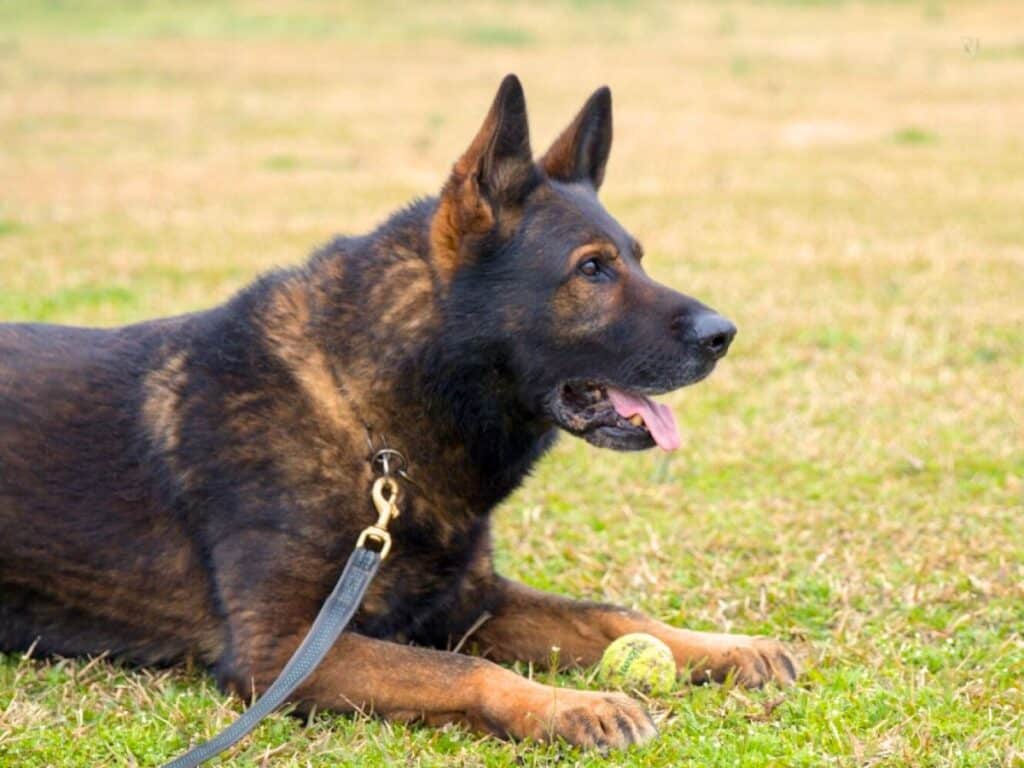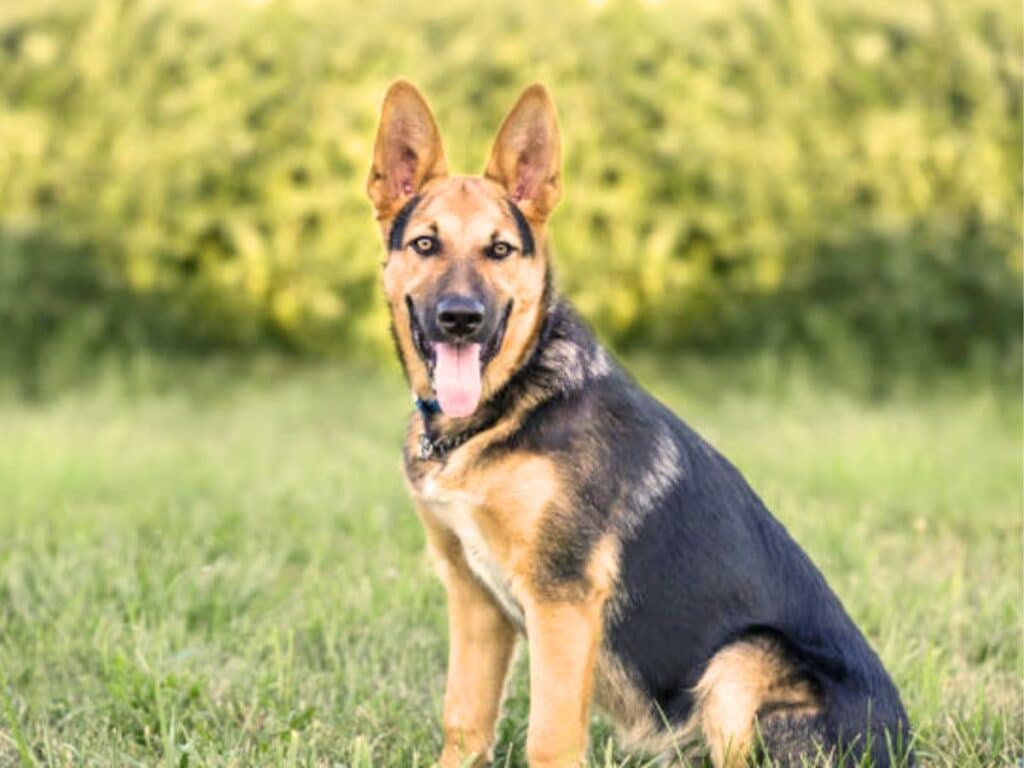While the German Shepherd breed is renowned for its courage and protective instincts, the female German Shepherds, in particular, exhibit a blend of grace, determination, and unwavering loyalty that sets them apart.
So I have decided to dedicate this article to the female German Shepherds and give you answers to all the questions that you may have about these magnificent creatures.
We will cover everything from their weight and size to their temperament and heat cycle, and by the end of reading this article, you will have gained a comprehensive understanding of female German Shepherds.
So let’s dive in!
Female German Shepherd: Overview
The following table summarizes the key characteristics of a female German Shepherd that potential owners and enthusiasts may find valuable. From size and lifespan to coat colors, temperament, and health considerations, this concise guide aims to offer a snapshot of what to expect when welcoming a female German Shepherd into your life.
| Characteristic | Description |
|---|---|
| Weight | 50 to 70 pounds (23 to 32 kg) |
| Height | 22 to 24 inches (56 to 61 cm) |
| Lifespan | 9 to 13 years |
| Coat | Double coat with a dense undercoat and medium-length outer coat |
| Temperament | Intelligent, loyal, versatile, trainable, and protective |
| Exercise Needs | High; requires regular exercise and mental stimulation (1-2 hours/day) |
| Trainability | Highly trainable, responds well to positive reinforcement |
| Good for family | Yes |
| Reproductive Cycle | Experiences heat cycles approximately twice a year |
| Ideal Time for Spaying | Typically spayed between 6 to 9 months of age, before the first heat cycle |
| Common Health Issues | Hip dysplasia, elbow dysplasia, degenerative myelopathy, allergies, and more |

Physical Characteristics
Female German Shepherd Weight
Female German Shepherds typically weigh between 50-70 pounds (23 to 32 kg), making them slightly lighter than their male counterparts. This weight range gives them a sturdy yet agile build, ideal for their role as working dogs.
Despite being robust and athletic, they exude grace and poise that are unique to the females of this breed. Their refined features include a sleeker head structure, giving them a more delicate facial expression compared to males.
Female German Shepherd Size
In terms of height, female German Shepherds usually stand between 22-24 inches (56 to 61 cm) at the shoulder. This moderate stature contributes to their agility and versatility in different environments.
The graceful curves of a female German Shepherd’s body accentuate her femininity without compromising strength or athleticism. These physical attributes make them not only capable working dogs but also striking companions with an air of sophistication.
Female German Shepherd Growth Chart
The following chart provides a framework for understanding the expected size, weight, and key characteristics at various age points of a female German Shepherd.
This chart can help you tailor your care routines to meet the specific needs of your female GSD as she transitions from a lively pup to a magnificent and fully developed adult companion.
| Age | Female GSD Height | Female GSD Weight |
| 1 Month | 3 – 6” | 4.5 – 8 lbs |
| 2 Months | 6 – 9” | 11 – 17 lbs |
| 3 Months | 8 – 10” | 17 – 26 lbs |
| 4 Months | 10 – 12” | 31 – 35 lbs |
| 5 Months | 12 – 14” | 35 – 44 lbs |
| 6 Months | 15 – 17” | 44 – 49 lbs |
| 7 Months | 17 – 19” | 49 – 53 lbs |
| 8 Months | 18 – 20” | 53 – 57 lbs |
| 9 Months | 19 – 21” | 55 – 60 lbs |
| 10 Months | 19 – 21” | 57 – 62 lbs |
| 11 Months | 20 – 22” | 60 – 64 lbs |
| 12 Months | 20 – 22” | 60 – 64 lbs |
| 1.5 Years | 21 – 22” | 60 – 66 lbs |
| 2 Years | 21 – 22” | 60 – 66 lbs |
| 3 Years | 22 – 24” | 66 – 70 lbs |
RELATED: Female German Shepherd Growth Chart By Age

Female German Shepherd Personality & Behavior
Female German Shepherds are renowned for their intelligent, loyal, and versatile nature. While individual personalities can vary, there are common temperament traits and behaviors that are often associated with female members of this breed:
- Intelligence: Female GSDs are highly intelligent dogs. They are quick learners and excel in obedience training. Their sharp minds make them adaptable to various roles, including police work, search and rescue, and service tasks.
- Loyalty: Female GSDs are known for their unwavering loyalty to their families. They form strong bonds with their owners and are protective of their loved ones. This loyalty, coupled with their alertness, makes them excellent guard dogs.
- Trainability: Due to their intelligence and eagerness to please, females are highly trainable. They respond well to consistent, positive reinforcement training methods. Early socialization is essential to ensure they grow into well-mannered adults.
- Protectiveness: With a natural protective instinct, female GSDs make excellent watchdogs. They are alert and will often vocalize if they sense a potential threat.
- Energetic and Active: Female GSDs are an energetic and active breed. Regular exercise is crucial to keep them physically and mentally stimulated. They enjoy activities such as fetch, agility, and long walks, making them great companions for individuals with an active lifestyle.
- Affectionate: While they may have a strong and protective side, female GSDs can be affectionate and loving with their families. They often form strong bonds with children and can be gentle and patient, especially when raised in a loving environment.
- Versatility: Female GSDs are versatile dogs that thrive in various roles. Beyond being loyal family companions, they excel in tasks such as search and rescue, police work, and serving as assistance or therapy dogs. Their versatility is a testament to their intelligence and adaptability.
- Playful and Social: Female GSDs enjoy playtime and social interactions. They appreciate being included in family activities and may form bonds with other pets when introduced properly. Regular socialization helps prevent any potential timidity or aggression.
It’s essential to note that proper training, socialization, and consistent positive reinforcement are crucial for nurturing a well-balanced and well-behaved female German Shepherd.
RELATED:

Female German Shepherd Heat Cycle
The heat cycle, or estrous cycle, is a natural reproductive process in female dogs, including German Shepherds.
Here’s an overview of the female German Shepherd’s heat cycle:
- Proestrus (Approximately 9 days):
- This is the beginning of the heat cycle.
- Female GSDs may exhibit signs such as vaginal bleeding, swollen vulva, and increased urination.
- During this phase, females are not receptive to mating and may appear disinterested or even irritated by male dogs.
- Estrus (Approximately 9 days):
- This is the mating phase of the cycle.
- The bleeding becomes lighter or may stop completely.
- The female becomes more receptive to males and may actively seek their company.
- Ovulation occurs during this stage, and mating can result in pregnancy.
- Diestrus (Approximately 60 days):
- If the female is not bred, she enters diestrus.
- During this period, hormonal levels drop, and the female is no longer receptive to mating.
- The reproductive organs return to their normal size.
- If the female is pregnant, gestation occurs during this stage.
- Anestrus (Variable duration):
- This is the resting phase of the cycle.
- Female GSDs are neither in heat nor pregnant during anestrus.
- The length of anestrus can vary between individuals but typically lasts several months.
Keep a close eye on your dog, especially during the estrus phase when she is receptive to mating. If you do not intend to breed your dog, prevent unsupervised interactions with intact male dogs.
Female dogs in heat may require extra attention to hygiene. Use doggy diapers or keep the living area clean to manage any discharge.
How long does a female German Shepherd’s heat cycle last?
The duration of a female German Shepherd’s heat cycle, or estrous cycle, can vary, but it typically follows a general pattern. On average, the complete cycle lasts about 21 days, although it can range from 18 to 24 days.
What is the frequency of a female German Shepherd’s heat cycle?
The frequency of a German Shepherd’s heat cycles, or estrous cycles, can vary from dog to dog. On average, female dogs experience two heat cycles per year, but this is a generalization, and individual variations are common. Some female GSDs may go into heat every 6 to 8 months, while others might have less regular cycles.
Female German Shepherd Heat Cycle Chart
This chart below serves as a visual and informational guide, detailing the various stages of a female GSD’s heat cycle, including proestrus, estrus, diestrus, and anestrus.

RELATED:
- German Shepherd Heat Cycle: Length, Frequency, & Stages
- Neuter or Spay Your German Shepherd: Timing, Pros & Cons
Female German Shepherd in Heat Behavior
The behavior of a female German Shepherd during her heat cycle can vary, and it’s typically influenced by hormonal changes.
Here’s a closer look:
- Restlessness: Females may show signs of restlessness and may be more prone to pacing or wandering during proestrus and estrus.
- Increased affection: Some females become more affectionate, seeking attention and physical contact from their owners.
- Protectiveness: The protective instinct may be heightened during the heat cycle, particularly if there is interest from male dogs. Owners may observe increased vigilance and territorial behavior.
- Changes in appetite: Appetite changes are possible, with some females exhibiting increased or decreased interest in food.
- Interaction with males: During estrus, the female may actively seek out interactions with male dogs. This behavior is a clear signal of her receptivity to mating.
- Potential behavioral challenges: Unspayed females in heat may experience behavioral challenges, such as being more prone to escaping or becoming more assertive. This underscores the importance of supervision and proper management.
It’s crucial for owners to be aware of these behavioral changes and to take appropriate measures, whether it’s closely supervising their dog, providing additional attention, or considering spaying to manage the heat cycle and associated behaviors.
Female GSD in Heat Smell
During a female German Shepherd’s heat cycle, there can be changes in her scent that may attract male dogs. This is a natural part of the reproductive process, and the female’s body releases pheromones that signal her receptivity to mating.
Female dogs in heat may produce a vaginal discharge, and this discharge can contribute to the change in scent. The scent can be most pronounced during the estrus stage of the heat cycle when the female is actively receptive to mating.
RELATED: Male vs Female German Shepherd: Key Differences

German Shepherd Health Issues
Female German Shepherds are not prone to any health issues specifically because of their gender. However, the German Shepherd breed is prone to the following health concerns:
- Hip Dysplasia: A hereditary condition where the hip joint doesn’t develop properly, leading to arthritis and pain.
- Elbow Dysplasia: Similar to hip dysplasia, this is a malformation of the elbow joint that can cause lameness and arthritis.
- Degenerative Myelopathy: A progressive spinal cord disease that affects the hind limbs, leading to weakness and paralysis.
- Exocrine Pancreatic Insufficiency (EPI): A condition where the pancreas doesn’t produce enough digestive enzymes, leading to malnutrition.
- Gastric Dilatation-Volvulus (Bloat): A life-threatening condition where the stomach fills with gas and twists on itself.
- Hemangiosarcoma: A type of cancer that can affect the blood vessels, often found in the spleen, liver, or heart.
- Epilepsy: Some German Shepherds may be prone to seizures, which can be managed with medication.
- Allergies: German Shepherds can be prone to skin allergies, food allergies, or environmental allergies.
Regular veterinary check-ups, a balanced diet, proper exercise, and attention to the specific needs of the breed can help manage and prevent certain health issues.
RELATED: German Shepherd Common Health Problems

Female German Shepherd vs Male
Below is a table outlining some general differences between male and female German Shepherds:
| Characteristic | Male German Shepherd | Female German Shepherd |
|---|---|---|
| Height | 24-26 inches | 22-24 inches |
| Weight | 65-90 pounds | 50-70 pounds |
| Temperament | Maybe more assertive or dominant | Generally more nurturing and maternal |
| Territorial Behavior | Tends to mark territory more frequently | May exhibit territorial behavior but less frequently |
| Aggression | Can display more assertiveness, particularly with other males | May show assertiveness but can be less confrontational |
| Trainability | May be slightly more challenging to train due to dominant tendencies | Generally easier to train, more focused on pleasing the owner |
| Energy Level | Often more energetic | Slightly more adaptable energy levels |
| Bonding with Family Members | Forms strong bonds with all family members | Forms strong bonds but may have a closer connection with one person |
| Heat Cycles | Does not experience heat cycles | Experiences heat cycles approximately twice a year |
| Spaying/Neutering Considerations | Neutering can reduce territorial and aggressive behaviors | Spaying can reduce heat-related behaviors and unwanted pregnancies |
| Social Dynamics with Other Dogs | Maybe less tolerant of same-sex dogs, particularly if not neutered | Generally more tolerant of other dogs, including females |
| Watchdog Instincts | Often more protective and assertive in guarding the home | Protective, but may exhibit a slightly less assertive approach |
| Maturity Rate | May mature more slowly, taking longer to reach full adulthood | Tends to mature more quickly, reaching adulthood sooner |
It’s important to note that individual variations exist, and the behavior and characteristics of each dog can be influenced by factors such as genetics, training, and socialization.

Pros & Cons of Female German Shepherds
Pros:
- Affectionate and nurturing: Female GSDs are often perceived as more affectionate and nurturing. They may be more in tune with their owner’s emotions and actions and may exhibit maternal instincts.
- Easier to train: Female GSDs are easier to train than males because they are more inclined towards pleasing the owner.
- Less aggressive: Generally, female GSDs tend to be less aggressive than males, especially in multi-pet households. This can make them easier to integrate into a family with other pets.
- Less territorial: Female GSDs may be less territorial than males, which can make them more adaptable to various environments and less prone to marking their territory.
- Loyal & protective: Female GSDs are generally very loyal to their families. They often form strong bonds with their owners and are naturally protective, making them excellent guard dogs.
Cons:
- Heat cycle: Female dogs go through heat cycles, which can be a consideration for owners who are not planning on breeding. Managing heat cycles requires extra attention to prevent unwanted pregnancies.
- Mood Swings: Some female GSDs may experience mood swings during their heat cycles, which can affect their behavior. They might become more sensitive, irritable, or less predictable.
- Selective bonding: Female German Shepherds may become more selective in their bonding compared to males. This can result in a stronger attachment to one family member over others.
- Potential for aggression: While females are generally less aggressive, they may show aggression if they feel their territory or puppies are threatened. This is especially true if the female is not spayed.
- Reproductive health considerations: Unspayed females are at risk for certain health issues, including pyometra (uterine infection) and an increased risk of certain cancers.
Frequently Asked Questions
Are Female German Shepherds Protective?
Yes, female German Shepherds are renowned for their innate protective instincts, displaying a strong sense of loyalty and devotion to their families.
These intelligent and trainable dogs often excel in protective roles, making them sought-after choices for guard and service work.

Are Female German Shepherds Aggressive?
While individual temperament varies, female German Shepherds are not inherently aggressive. Aggression in German Shepherds is often a result of factors such as inadequate training, poor socialization, or medical issues.
With proper training, early socialization, and positive reinforcement, female GSDs can exhibit a balanced and well-behaved demeanor.
Are Female German Shepherds Smaller Than Males?
In general, female German Shepherds tend to be slightly smaller than their male counterparts. Adult female GSDs typically stand between 22 to 24 inches at the shoulder and weigh around 50 to 70 pounds, while males usually range from 24 to 26 inches in height and weigh between 65 to 90 pounds.
Are Female German Shepherds Good Guard Dogs?
Yes, female German Shepherds are widely recognized for their exceptional qualities as guard dogs. Known for their intelligence, loyalty, and protective instincts, female GSDs can be highly effective in guarding homes and families.
These dogs possess a keen sense of alertness, making them quick to detect and respond to potential threats.
Are Female German Shepherds Good Family Dogs?
Yes, female German Shepherds are known for being excellent family dogs due to their loyalty, intelligence, and affectionate nature.
These versatile and trainable companions often form strong bonds with their human pack members, making them devoted and protective family members. Their gentle demeanor, especially when well-socialized from an early age, allows them to interact well with children.

Are Female German Shepherds Easier to Train?
Yes, female German Shepherds are often praised for their intelligence and eagerness to please, making them generally easier to train.
Their high level of trainability stems from a combination of natural intelligence, strong work ethic, and a desire to form a strong bond with their owners.
Female GSDs are known for quickly grasping commands and tasks, making them suitable candidates for various training endeavors, including obedience, agility, and even specialized roles like search and rescue.
Are Female German Shepherds More Protective Than Males?
The level of protectiveness in female and male German Shepherds can vary based on individual temperament, training, and socialization rather than a strict gender-based trait.
While some may perceive females as being slightly more protective due to their maternal instincts, both genders are known for their protective instincts and the degree of protectiveness often depends on factors such as genetics and early experiences.
Can Female German Shepherds Be Police Dogs?
Yes, female German Shepherds can and do excel as police dogs. In fact, many law enforcement agencies actively utilize female German Shepherds as part of their K-9 units.
Renowned for their intelligence, trainability, and keen sense of smell, female GSDs possess the qualities necessary for police work.
They are often employed in various roles, including tracking, search and rescue, narcotics detection, and apprehension.
When Can Female German Shepherds Get Pregnant?
Female German Shepherds typically reach sexual maturity and can become pregnant for the first time during their first heat cycle, which usually occurs between the ages of 6 to 12 months.
However, it’s important to note that while a female may physically be capable of reproduction during her first heat, early breeding is generally not recommended.
Breeding a dog too early can pose health risks for the female and may result in complications during pregnancy and birth.

Can Two Female German Shepherds Live Together?
Yes, two female German Shepherds can live together successfully, but careful consideration and proper introduction are crucial. The compatibility of two female dogs often depends on their individual personalities, socialization experiences, and the dynamics within the household.
Additionally, ensuring that each dog receives individual attention, exercise, and a clear understanding of their place in the hierarchy can help prevent conflicts.
Can a Male and Female German Shepherd Live Together?
Yes, a male and female German Shepherd can live together quite successfully. Opposite-sex pairings, like having a male and female dog, are often more harmonious than same-sex pairings, as they are less prone to rivalry.
Introducing them properly, early socialization, and consistent training are crucial for fostering a positive relationship.
Do Female German Shepherds Have Periods?
Yes, female German Shepherds go through a reproductive cycle, often referred to as their heat cycle or estrous cycle, during which they experience different stages including proestrus, estrus, diestrus, and anestrus.
During proestrus and estrus, female dogs may exhibit signs such as vaginal bleeding and changes in behavior, marking their receptive period for mating.
Do Female German Shepherds Live Longer Than Males?
According to recent research, female German Shepherds lived on average 1.4 years longer than males (11.1 years versus 9.7 years). Typically, German Shepherds have a lifespan ranging from 9 to 13 years.
While the lifespan of a German Shepherd, whether male or female, is influenced by various factors such as genetics, overall health, diet, exercise, and the quality of veterinary care, female GSDs do seem to live longer than males.
RELATED: Female German Shepherd Lifespan: How Long Do They Live

Do Female German Shepherds Prefer One Person?
Female German Shepherds, like many dogs, can form strong bonds with individual members of their human family.
While they are known for their loyalty and devotion to their entire pack, including all family members, it’s not uncommon for them to develop a particularly close relationship with one person.
Do Female German Shepherds Mark Their Territory?
While male dogs are more commonly associated with marking behaviors, female German Shepherds may also engage in territorial marking, albeit less frequently.
Female dogs, especially during their heat cycle, may exhibit marking behavior as a way to signal their reproductive status.
Do Female German Shepherds Grow Faster Than Males?
Both male and female German Shepherds undergo a period of rapid growth during their puppyhood, with females typically reaching physical maturity around 18 to 24 months.
A female GSD will gradually grow until they reach age 2, and a male will fill out until about two and a half years old.
RELATED: When Do German Shepherds Stop Growing?
Do Female German Shepherds Change After Being Spayed?
While spaying can contribute to a calmer demeanor and a decrease in behaviors associated with the reproductive cycle, individual responses may vary. Owners need to note that spaying does not alter the fundamental aspects of a dog’s personality, intelligence, or trainability.

Do Female German Shepherds Like To Cuddle?
While German Shepherds are often known for their loyalty and affectionate nature, individual personalities play a significant role in determining whether a particular female German Shepherd enjoys cuddling.
Many GSDs do form strong bonds with their owners and may enjoy physical closeness, including cuddling on the couch or lying beside their family members.
RELATED: Do German Shepherds Like To Cuddle?
How Long Does Female German Shepherd Live?
The lifespan of a female German Shepherd typically ranges between 9 to 13 years, although individual variations may occur. Numerous factors influence a German Shepherd’s longevity, including genetics, overall health, diet, exercise, and the quality of veterinary care.
How Many Nipples Does a Female German Shepherd Have?
A female German Shepherd typically has eight to ten nipples. This number may vary slightly among individual dogs, but it is a common range for the mammary glands in female canines. Nipples play a crucial role in lactation during pregnancy and nursing, providing nourishment to the puppies.
How Many Puppies Can a Female German Shepherd Have?
The number of puppies a female German Shepherd can have in a single litter can vary but generally ranges from 6 to 8 puppies. However, litter sizes can be influenced by factors such as the dog’s age, health, genetics, and overall reproductive condition.
Litter size of as small as 1 pup and as large as 15 puppies is not uncommon.
RELATED: How Many Puppies Can a German Shepherd Have?
When Should You Spay a Female German Shepherd?
The optimal time to spay a female German Shepherd is a decision that can be influenced by various factors. Many veterinarians recommend spaying before the first heat cycle, typically between 6 and 9 months of age.
Spaying at this age can offer several health benefits, including a reduced risk of certain reproductive cancers and unwanted behaviors associated with the heat cycle.
Summary
German Shepherds, known for their intelligence and loyalty, make wonderful companions regardless of gender. Prospective dog owners should focus on understanding the specific needs of the individual dog, considering factors such as training, socialization, and overall health. Whether male or female, a well-cared-for German Shepherd can bring immense joy and companionship to a household.




